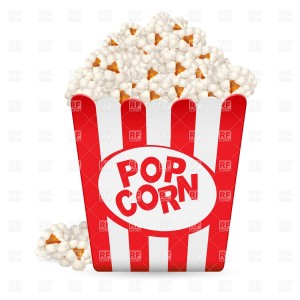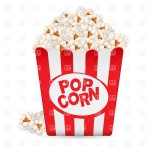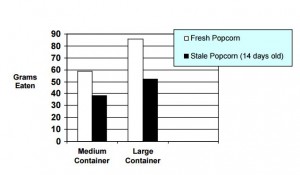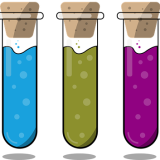Addicted to feeling overfull?….hunger for weight loss
Do you ever find yourself mindlessly snacking or eating something you don’t even really like? You are not alone. In this article we discuss research on behavior. You can then use this information to be mindful and use tips and tricks starting today so you can lose weight or achieve that flat belly you desire.
Cornell University did a study in 2005 where participants were offered popcorn for free at a movie theater in exchange for their feedback. What they didn’t tell the participants is that some of the popcorn was stale. They wanted to test how people would react in response to snacking while being distracted (in this case, by watching a movie) and how portion sizes would affect it. The results were surprising. They found that “environmental cues” such as package and portions sizes influenced consumption of food for both adults and children.

Doubling the size of a container has generally translated into a 18-25% increase in consumption for many meal-related foods (such as spaghetti) and a 30-45% increase in many snack-related foods.
The moviegoers ate an average of 45.3% more popcorn from a large container than from a medium container when the popcorn was fresh. In fact, 73 of 86 moviegoers who were given stale popcorn had described the popcorn with negatively remarks such as “stale,” “soggy,” or “terrible.” In spite of these negative reactions toward this stale 14 day old popcorn, Figure 1 (below) illustrates that moviegoers who had been given large containers ate 33.6% more than those given the medium-size containers. Container size increased consumption for both the fresh and stale popcorn.


Many people do not carefully monitor how much they eat, and they can be influenced by consumption norms suggested by larger packages and portions, especially since distracting or engaging situations may foster or encourage mindless eating where people can be influenced by container size and portion size even when the food does not taste good.
The study suggested three conclusions for nutrition educators:
1) Be aware that portion size and package shapes can affect our consumption of tasty foods as well as ones that are not as tasty. Even if a person does not particularly care for a food, “grazing” from a large bowl will cause them to eat more.
2) It may be possible to increase the consumption of less-than-favorable healthy foods, particularly among populations of children and the elderly, by serving them in larger bowls. One rule-of-thumb is that the portion size of a food should vary with the healthfulness of that food.
3) Larger bowls of carrot sticks or other raw vegetables or fruit might encourage greater consumption in distracting environments, such as while watching television or snacking at a party.
Here’s how you can trick your mind and put action items into practice from the findings of his study.
- Become aware of your own environmental cues or triggers (parties, stress, lack of sleep, thirst, food influenced situations, family gatherings, being alone, boredom)
- Choose a smaller container size or portion size – Ditch the notion that the size of a serving suggested is the “consumption norm” of how much is appropriate to consume. If you are someone that has to get a second serving even when you know you don’t need or want it then eating from a smaller plate will help you fulfill the need to get more even if only a little bit more.
- Make eating a ritual and eat at a table or look out at nature. Make putting something in your mouth a big deal even if for only for a few minutes. Be thankful that you don’t have to hunt your food or climb a tree to enjoy it. The fact that you are stopping to consume nutrition and fuel for your body can be a moment of reflection.
- If you insist on watching T.V. or use an electronic device while eating then measure out your serving and make it harder to get more easily. Watch my video below for tips on this.
- Get in touch with how to feels to actually be hungry and on the other end of the spectrum when you are satiated. My kids loved seeing episodes of the t.v. series Naked & Afraid. They would make comments on how much weight the individuals would lose. Duh, when you can get food whenever you want and in any size you want, how good are you at monitoring portions? That’s where the small plates and containers come into play yet again.
The truth is, feeling hungry can be a good thing. Think of it this way: some of us munch all day, never feeling too full, but never actually giving our body time to become hungry. And some people have learned to mistakenly describe other emotions (such as loneliness or boredom) as feeling hungry and eating in response. But arriving at the dinner table with a nice appetite is an essential ingredient to good food, and truly enjoying our meal.
Some weight loss counselors suggest using a tool called the Hunger Scale to help reconnect people with eating in response to their body’s true hunger and fullness cues. The concept is simple: When you use the Hunger Scale, you don’t eat until you notice that you are pleasantly hungry (not starving), and you stop eating when you are pleasantly full (not stuffed).
Is your kitchen set up for nutrition success?
Check out my video kitchen changes and behavior change for more tips.
Tonya Tittle, M.S., ACSM, Owner/Energy Fitness, 552 S. Main, Memphis, TN 38103
Not a client? Live in town and interested in our personal training or nutrition coaching? Click here for a FREE Consult (value $87) or give us a call at 901-466-6242
Check out our customized online training ($40-$80) here: Online Customized Training
Interested in our Massage or Body Wraps? Click here.




